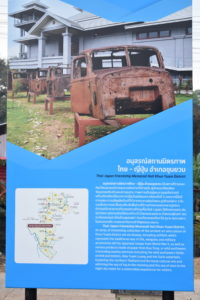Whilst driving from Mae Hong Son to Chiang Mai, our guide suggested we stop at Khun Yuam which is very near the Thailand-Myanmar border.
It had been a provincial town trading peacefully with Myanmar, with ox carts carrying goods like rice, salt, clothes, candles and opium between the two countries. However, in 1942, 5-6,000 Japanese soldiers marched into town. By the time the war ended, it was estimated that over 270,000 soldiers had passed through on the way to the Myanmar battlefields.
The Thai-Japan Friendship Memorial Hall, is a two-story museum setting out what followed in the years to come.
We started with a 10-minute film before viewing the first floor with its various artefacts belonging to the Japanese: weapons, uniforms, personal effects left behind, ammunition etc. We read the story of how the Japanese commandeered their temples for different purposes including hospitals.
You might have thought there would have been some element of animosity between the two countries, but apparently, the Japanese made friends with the local people and helped them with their harvest and provided goods and clothes when they were in short supply. The Thais helped the Japanese build a road and were paid a decent wage. As a result of the good relationship, many Japanese soldiers ended up marrying local girls.
The floor above was devoted to the local Tai ethnic tribe and their annual life cycle (their year starts with December), the food they eat, their customs, religion etc.
Outside were rusted Japanese vehicles discovered over the years and a statue of two children releasing a crane, the symbol of hope and healing.
The information boards read ‘the war gave the people of Khun Youm the chance to unexpectedly greet thousands of unfamiliar visitors’. However, having visited Kanchanaburi and seen how the local people were treated, we left the museum feeling slightly uneasy about what we’d read and seen.








